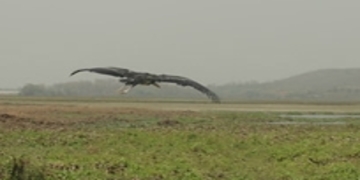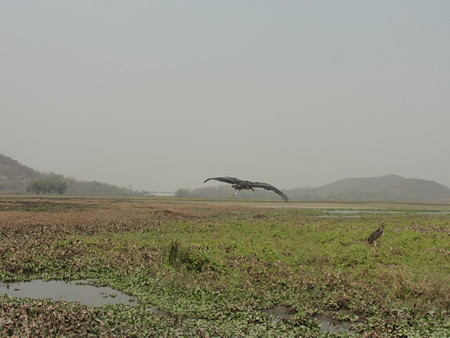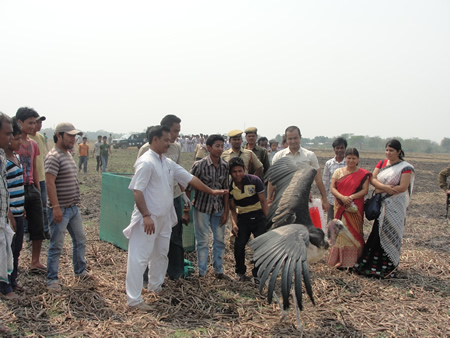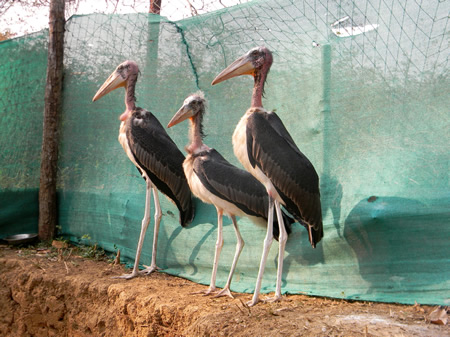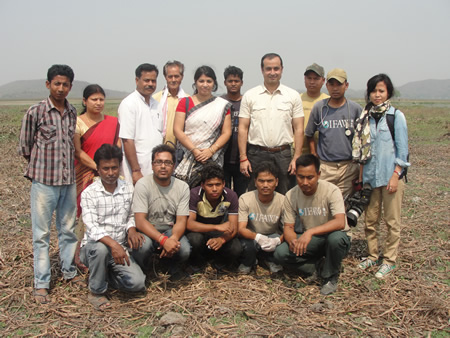Endangered greater adjutants rehabilitated in Assam
Guwahati (Assam), March 22, 2013: Four endangered greater adjutant stork (Leptoptilus dubius) juveniles were set free yesterday in Dadhara, about 16 km from Guwahati. The birds, which had falled from their nests in Dadhara – believed to be the world’s biggest nesting site for the species – were rescued under a Rapid Action Project (RAP) implemented by a local headmaster Paresh Das, supported by Wildlife Trust of India (WTI) and the Charities Aid Foundation (CAF) India.
Assam is the largest nesting ground for this bird and as per IUCN Red List estimates, only about 1000-1200 mature individuals remain. This species is also found in Cambodia. Another WTI-supported RAP had helped identify a breeding population in Bihar in the mid-2000s.
Getting it’s final push. Photo by: Nizira Borgoyari/WTI
| Three of the storks when they were in the transit home in Kokrajhar
Photo by: Panjit Basumatary/WTI |
“The Brahmaputra floodplain is the main stronghold for the greater adjutants. The nesting sites are scattered here, but Dadhara has more than 100 nesting trees, which makes it perhaps the biggest nesting site in the country and maybe in the world,” said Dr Rathin Barman of WTI.
Loss of nesting trees remain one of the major threats to these storks. They are also threatened by chicks falling off the nests, the intensity of which increases with over-crowding.
Supported by the Charities Aid Foundation, WTI provided the grant to Paresh Das, a local school headmaster, who had proposed the RAP to save chicks that had fallen out of their nests. Nets were placed under nesting trees to break their fall. Once rescued, they were transported to IFAW-WTI run CWRC (Centre for Wildlife Rehabilitation and Conservation) Transit Home in Kokrajhar for hand-raising.
“More than 20 storks die annually in Dadhara – mostly juveniles that have fallen out of their nests. With the support of local NGOs and medical attention provided by IFAW-WTI, this year we are successful in saving a good number of them,” said Das, who is also getting his stundents involved in the project. The birds were released by Partha Sarathi Mahanta, Superintendent of Police (SP), Kamrup Rural.
“An identification mark has been engraved on the released birds,” said Research Scholar Purnima Devi Barman of NGO Aaranyak. “Post-release monitoring will be carried out for next three months. The local NGOs and villagers will help in monitoring the birds.”
IFAW-WTI veterinarian Dr Panjit Basumatary, who looked after the birds, said, “The released chicks weigh 9, 10 and 12 kgs respectively and were healthy during release. They immediately flew off and landed on the fields and began hopping around.”
“This whole exercise of saving few stork chicks has brought the entire community in and around Dadhara together, for the cause of conservation,” said Dr Bhaskar Choudhury, Regional Head – Northeast, WTI. “This is an excellent example of how rehabilitation can build strong awareness and educate masses. It is heartening to see that even policy-makers and top government officials have taken time out to come forward and participate in this. We are happy to be a part of this novel initiative.”

